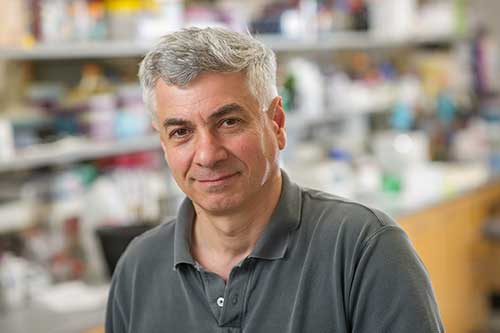There are more bacteria in our mouths than the population of people on the planet, and no matter how clean our houses are, they’re brimming with various types of these micro-organisms. Still, despite bacteria’s ubiquitous influence, there’s so much that scientists do not know about them, according to University of Notre Dame chemist Shahriar Mobashery.
That is why he is excited about the findings in his recent publication, which describes an aspect of how a common bacterium, pseudomonas, replicates. The paper was published recently in Nature Communications, a collaboration with the lab of Juan Hermoso – a structural biologist and professor at Instituto Quimica-Fisica Rocasolano in Madrid, Spain.

“Understanding everything about how bacteria tick is critical,” said Mobashery, the Navari Family Professor in Life Sciences in the Department of Chemistry and Biochemistry. “This is profoundly important, and it was a bit of a shock when genomic information came out for the first time in the middle 1990s, and people realized how little they understood about E. coli – a bacterium that we had already been studying for the previous 100 years.”
Pseudomonas is an oblong-shaped bacterium that, just before replication, looks like one link in a sausage strand. First the bacterium doubles in length, and then cuts itself in half to become two functioning daughter cells. The separation of the two cells, called septation, must be completed without a hitch in order for the cell walls of both daughter cells to close off. Otherwise, the bacteria will die.
In order to separate the two “links” of the daughter cells, an enzyme within the cell chips away at the existing structure of the cell wall, said Mobashery, whose lab creates portions of cell walls for study. This process then initiates additional synthesis of a new cell wall that becomes the septum, which is the end cap of the “sausage link.” For reasons scientists do not understand, the cell wall lacks peptides at the location where the division occurs, even though the peptide exists elsewhere in the cell wall.
Researchers in the Hermoso lab used X-ray crystallography to shed structural light on this process by revealing a property of an enzyme critical for septation. The protein, a segment of RlpA—called a sporulation-related repeat (SPOR) domain— structurally favors binding to the cell wall that lacks the peptide. This molecular recognition between the SPOR domain and this denuded, “bare” cell wall enables the process of septation by concentrating the critical activity of RlpA to the site.
Analyzing these fundamental processes, though highly technical and tricky to execute, are crucial to advancing medicine, said Mobashery, who is affiliated with the Eck Institute for Global Heath, the Warren Family Center for Drug Discovery, and Advanced Diagnostics and Therapeutics. That is why he continues exploring how bacterial cell walls function, and why he says the National Institutes of Health (NIH) has provided funding for his projects during the past 30 years.
This research describes an important aspect of how bacterial growth is linked to maturation of the cell wall in difficult-to-treat bacteria, including pseudomonas, which can cause infections of the lungs, skin, blood, and other parts of the body. Bacteria are not merely disease-causing micro-organisms. “Certain bacteria have evolved to co-exist in symbiosis with human beings,” Mobashery said. “Our well-being often depends on this co-existence, which has evolved over millennia.”
The study was funded by research grants from the NIH and through a graduate-student fellowship offered by Notre Dame’s Eck Institute for Global Health and a training grant from the NIH. In Spain, the work was supported by grants from the Spanish Ministry of Science, Innovation and Universities.
Originally published by at science.nd.edu on February 05, 2020.
